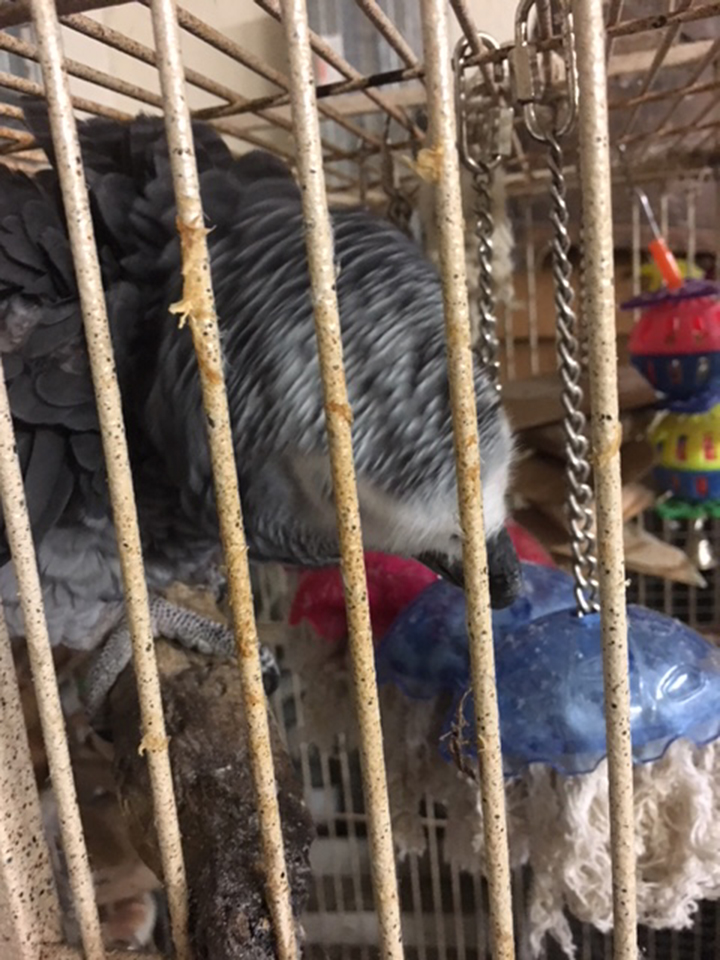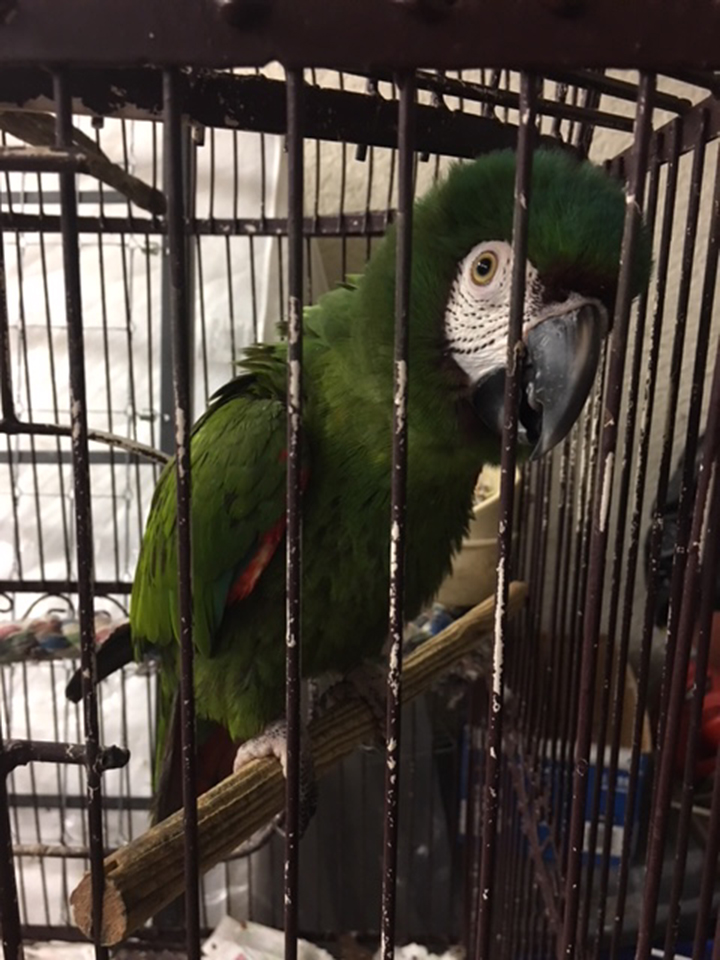
A Birds Eye View of a Parrot Rescue Event
Birds of Paradise has long operated an emergency rescue program for distressed, abandoned and abused parrots. In fact, the sanctuary was founded on just such an event in August of 2011. During this event, Debbie Huckaby rescued dozens of parrots in Troy Ohio that had been abandoned and were living in filth and extreme heat with no food and water. You can read more about this event here.
Although BOPS has performed several rescue events since then, I got to see firsthand what some real heroes look like the weekend of May 19th and, as I share this story, I for one am hopeful that the avian community can start a dialog about how we continue to triage such events—while simultaneously working to eliminate future occurrences.
After receiving a frantic call Saturday May 19, Debbie Huckaby initiated an emergency rescue event dubbed “The North Port 15”. This event started with a phone call from an individual that was desperately looking to place 15 parrots from a North Port Florida home because—yet again—the “unimaginable” happened. A close relative had died suddenly and there was no plan in place for these innocent birds.
After listening compassionately and praising the caller for her quick and rational thinking, Debbie and her team sprang to action. From prior experience with these situations, Debbie has a protocol for events like this—and she knows the immediate and urgent steps that needed to be taken to safeguard parrots in a situation where their daily care may be interrupted.
The rescue event itself happens in three stages. The first stage is preparation, and this involves a lot of planning and communication. The twist is that you only have a matter of hours to get all of this done.
Some of the steps, in no particular order, include calling the avian vet to schedule emergency care if required (and if not, routine exam visits for multiple birds); instructing the temporary guardian on how to feed and water the parrots (and dispatching a team member to do these services if the temporary guardian is unable to); discerning how many salvageable cages (if any) are coming with the parrots; making sure there is room in the quarantine area for the new arrivals; and future space planning for the parrots post the quarantine period. There are of course are many more steps, some logistical, some operational, some communication-based, that get folded into the event.
The amount of teamwork and coordination for this stage may seem daunting to some, but I observed that within an hour of the initial call, Debbie, her team and the temporary guardian quickly become one well-oiled machine.
Stage 2 is extraction and transport, where the BOPS team arrives at the location to greet the temporary guardian (coordinator) and performs an initial assessment of the scene. Keep in mind that in this case, like many in the past, the coordinator has done their best to answer preliminary questions and send some pictures—but there’s usually a surprise or two waiting in the wings (pardon the pun.)
On Sunday morning (May 20th), Debbie and her emergency rescue team headed to North Port and—although not surprised having done previous rescues—they were dismayed by what was an obvious hoarding situation. Although the parrot owner had good intentions, his flock steadily outgrew his capacity to care for them. Even worse, he had no continuity plan in the event of his sudden illness or death.
The living conditions of these parrots was heartbreaking. One had recently started mutilating (and would require immediate veterinary care) and several were plucked. Cages were spread throughout the house and each area was dirty and roach infested. Some areas had little to no natural light available. Many of the cages were too small for their occupants, most were covered in rust. One had a piece of broomstick masquerading as a perch—yet others had perches that had disintegrated and fallen to the bottom of the cage.
Debbie and the team worked methodically and efficiently. First, there was triage for the visibly injured parrot. Then, for each parrot there was a process, including visual assessment, a photograph, recording the species, documenting injuries or other health conditions and then noting cage conditions. Then, transport preparation. A meeting of the eyes and a gentle conversation with the parrot, the visual introduction of the transport cage, a loving arm extended to calm and coax each bird into this intermediate vessel that will magically change their lives forever.
A scene repeated many times. Multiple SUV’s now filled with lots of feathers and hope. 15 new BOPS feathered residents representing a spectrum of parrot species: Sun Conure, Macaw, Pionus, Indian Ringneck, African Grey and Quaker. A noisy drive back to the sanctuary, peppered with frequent down pours. It’s rainy season here.
Stage 3 is like stage 2, but in reverse. There’s an air of excitement—the type of excitement fueled by compassion and a job well done. Team members are exhausted, but roll up their sleeves and dig in.
As the SUV’s pull onto sanctuary property, stage 3 has begun. It’s raining on and off, the team is wet but undaunted. It’s clearly a bad hair day for all. As soon as Debbie’s feet hit the gravel she heads to the quarantine area and starts an inspection. Some cages are relocated, all are carefully inspected for bowls, perches and toys—and proximity to one another. Attention new residents, there’s a “no foot biting” policy in place.
As the unloading of the new residents from the SUV’s begins, there’s more pictures, more documentation, more gentle conversation, an extended arm, and finally an introduction to a new, albeit temporary living space. A safe space. A space where simple things like fresh fruits and veggies, a nutritional diet, and fresh water are just every day occurrences. A space where you get natural light and can make friends with your neighbors. A space full of hope for both parrots and people. A new beginning for all of us.
THE NORTH PORT 15 PARROT RESCUE
The rescue event itself is complete, but the healing journey for these parrots has just begun. Over the next several months, there will be visits to the veterinarian and re-socialization. Each parrot will get lots of one-on-one time with Debbie as she reinforces that she is now the flock leader and that they are safe. There will be long periods of mutual observation. Debbie knows that interpreting a parrot’s body language is a combination of skill and art. She’ll establish a unique communication with each one using well-practiced, yet subtle, evaluation techniques.
And when they are ready, they will let Debbie know where their happy place is. This may be as a constant companion in a loving home with a “human” family they have selected. Some of these parrots though may have been traumatized, are fearful of humans, have special needs, and/or are temperamentally unsuited for companionship with people. They will enjoy permanent residency at the sanctuary, with the love, respect and dignity that all our birds receive, in a nurturing, stable environment for the duration of their natural lives.
The challenge for us as an organization is that this vital emergency parrot rescue program comes with very real financial overhead. The initial rescue operation one-time expenses include veterinary exams & emergency care, travel and temporary cages. But that’s just the beginning. Rescued parrots often have special needs, including a range of physical handicaps or other challenges requiring unique living or feeding arrangements—and this increases operating overhead by about $1,000 a year per parrot as our standards of care includes a nutritionally balanced diet, housing, medical care, perches and toys.
To offset these costs, we’d like to start discussions with municipal agencies and corporate sponsors that understand how vital this Birds of Paradise Emergency Parrot Rescue program is for the community—and want to be a part of the good will.
Financial support is key, but there are other benefits municipal agencies and corporate supporters could provide, such as transportation assistance for parrots and cages between the pick-up location and the sanctuary; donating goods that support this program, such as temporary cages & aviary construction materials, metal carriers, gas cards, parrot food, etc.; bottled water, rain gear, boots & gloves for our emergency rescue team; and sponsoring a team of your own employee volunteers. These are just a few ideas we have… and we invite you to share any that you may have with us. We are listening 😉
We have also started a Parrot Pals sponsorship program where anyone can make a sustaining donation of $10 to $20 monthly. And of course, one-time donations are always appreciated and can be made here.






























